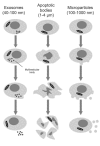Influence of red blood cell-derived microparticles upon vasoregulation
- PMID: 28686154
- PMCID: PMC5649961
- DOI: 10.2450/2017.0353-16
Influence of red blood cell-derived microparticles upon vasoregulation
Abstract
Here we review recent data and the evolving understanding of the role of red blood cell-derived microparticles (RMPs) in normal physiology and in disease progression. Microparticles (MPs) are small membrane vesicles derived from various parent cell types. MPs are produced in response to a variety of stimuli through several cytoskeletal and membrane phospholipid changes. MPs have been investigated as potential biomarkers for multiple disease processes and are thought to have biological effects, most notably in: promotion of coagulation, production and handling of reactive oxygen species, immune modulation, angiogenesis, and in apoptosis. Specifically, RMPs are produced normally during RBC maturation and their production is accelerated during processing and storage for transfusion. Several factors during RBC storage are known to trigger RMP production, including: increased intracellular calcium, increased potassium leakage, and energy failure with ATP depletion. Of note, RMP composition differs from that of intact RBCs, and the nature and composition of RMP components are affected by both storage duration and the character of storage solutions. Recognised RMP bioactivities include: promotion of coagulation, immune modulation, and promotion of endothelial adhesion, as well as influence upon vasoregulation via nitric oxide (NO) scavenging. Of particular relevance, RMPs are more avid NO scavengers than intact RBCs and this feature has been proposed as a mechanism for the impaired oxygen delivery homeostasis that has been observed following transfusion. Preliminary human studies demonstrate that circulating RMP abundance increases with RBC transfusion and is associated with altered plasma vasoactivity and abnormal vasoregulation. In summary, RMPs are submicron particles released from stored RBCs, with demonstrated vasoactive properties that appear to disturb oxygen delivery homeostasis. The clinical impact of RMPs in transfusion recipients is an area of continued investigation.
Conflict of interest statement
The Authors declare no conflicts of interest.
Figures








Similar articles
-
Physiologic Impact of Circulating RBC Microparticles upon Blood-Vascular Interactions.Front Physiol. 2018 Jan 12;8:1120. doi: 10.3389/fphys.2017.01120. eCollection 2017. Front Physiol. 2018. PMID: 29379445 Free PMC article. Review.
-
Red blood cell storage time and transfusion: current practice, concerns and future perspectives.Blood Transfus. 2017 May;15(3):222-231. doi: 10.2450/2017.0345-16. Blood Transfus. 2017. PMID: 28518049 Free PMC article. Review.
-
Red blood cell-derived microparticles: An overview.Blood Cells Mol Dis. 2016 Jul;59:134-9. doi: 10.1016/j.bcmd.2016.04.003. Epub 2016 Apr 13. Blood Cells Mol Dis. 2016. PMID: 27282583 Review.
-
Nitric oxide scavenging by red cell microparticles.Free Radic Biol Med. 2013 Dec;65:1164-1173. doi: 10.1016/j.freeradbiomed.2013.09.002. Epub 2013 Sep 16. Free Radic Biol Med. 2013. PMID: 24051181 Free PMC article.
-
Storage Duration and Red Blood Cell-Derived Microparticles in Packed Red Blood Cells Obtained from Donors with Thalassemia.Lab Med. 2022 May 5;53(3):302-306. doi: 10.1093/labmed/lmab106. Lab Med. 2022. PMID: 34791365
Cited by
-
Biopreservation and Reversal of Oxidative Injury During Blood Storage by a Novel Curcumin-based Gel Formulation.Res Sq [Preprint]. 2024 May 6:rs.3.rs-4277591. doi: 10.21203/rs.3.rs-4277591/v1. Res Sq. 2024. Update in: Sci Rep. 2024 Dec 28;14(1):31441. doi: 10.1038/s41598-024-82943-1. PMID: 38766242 Free PMC article. Updated. Preprint.
-
Circulating Extracellular Vesicles and Endothelial Damage in Sickle Cell Disease.Front Physiol. 2020 Sep 3;11:1063. doi: 10.3389/fphys.2020.01063. eCollection 2020. Front Physiol. 2020. PMID: 33013455 Free PMC article. Review.
-
The Effect of Extracellular Vesicles on Thrombosis.J Cardiovasc Transl Res. 2023 Jun;16(3):682-697. doi: 10.1007/s12265-022-10342-w. Epub 2022 Nov 28. J Cardiovasc Transl Res. 2023. PMID: 36441349 Free PMC article. Review.
-
Intra-operative blood transfusion significantly increases the risk of post-operative pulmonary embolism.J Thorac Dis. 2019 Dec;11(12):5566-5571. doi: 10.21037/jtd.2019.11.10. J Thorac Dis. 2019. PMID: 32030276 Free PMC article.
-
Erythrocyte-derived microvesicles induce arterial spasms in JAK2V617F myeloproliferative neoplasm.J Clin Invest. 2020 May 1;130(5):2630-2643. doi: 10.1172/JCI124566. J Clin Invest. 2020. PMID: 32045382 Free PMC article.
References
-
- Boulanger CM, Dignat-George F. Microparticles: an introduction. Arterioscler Thromb Vasc Biol. 2011;31:2–3. - PubMed
-
- Morel O, Jesel L, Freyssinet JM, Toti F. Cellular mechanisms underlying the formation of circulating microparticles. Arterioscler Thromb Vasc Biol. 2011;31:15–26. - PubMed
-
- Burger D, Schock S, Thompson CS, et al. Microparticles: biomarkers and beyond. Clin Sci. 2013;124:423–41. - PubMed
-
- Del Conde I, Shrimpton CN, Thiagarajan P, Lopez JA. Tissue-factor-bearing microvesicles arise from lipid rafts and fuse with activated platelets to initiate coagulation. Blood. 2005;106:1604–11. - PubMed
Publication types
MeSH terms
Substances
Grants and funding
LinkOut - more resources
Full Text Sources
Other Literature Sources
